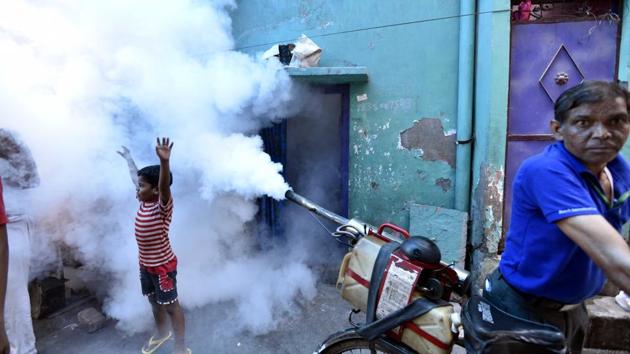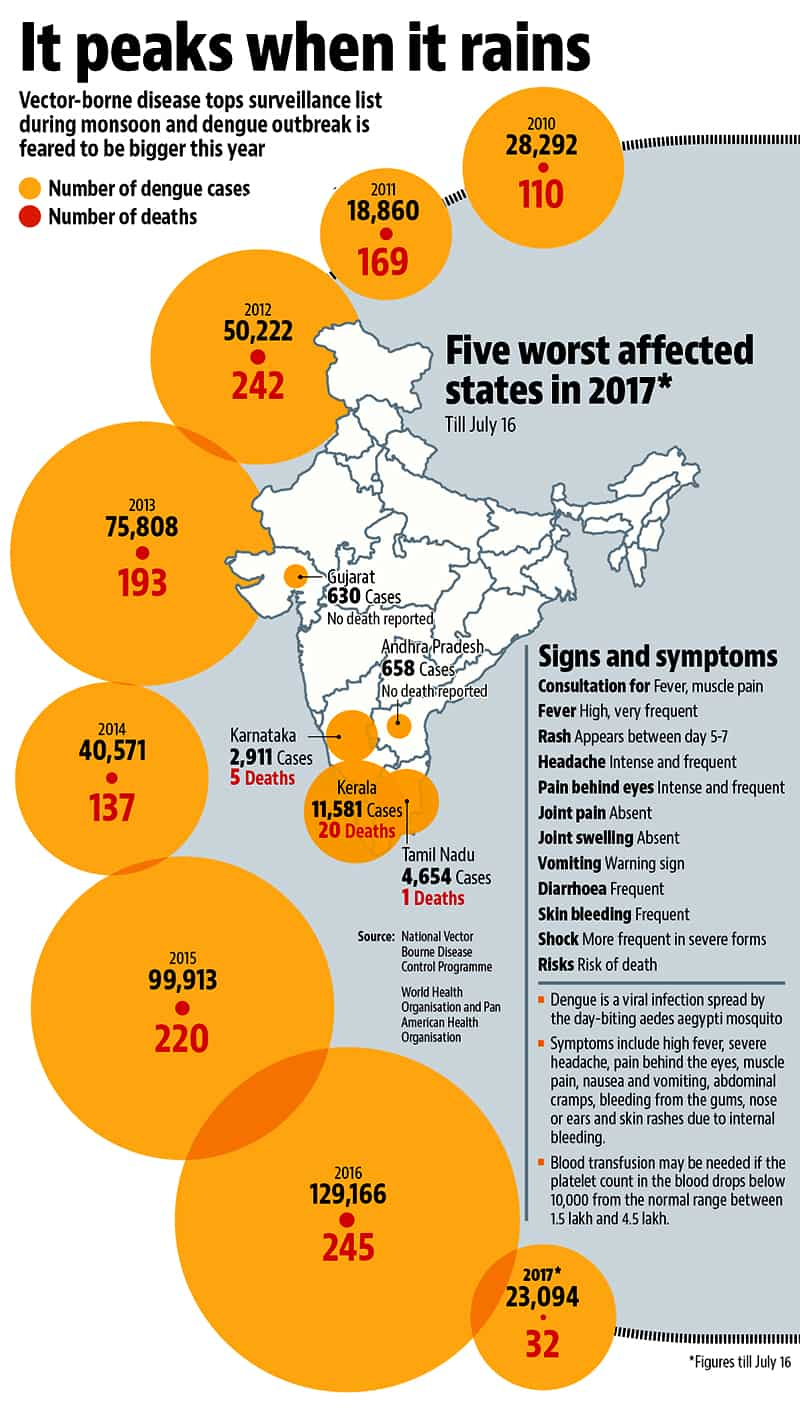Killer virus: South India worst hit as dengue spreads its tentacles
In 2016, close to 1.30 lakh cases and 245 deaths were reported from across the country, according to the National Vector Borne Disease Control Programme (NVBDCP), but the real numbers are even higher.
Kerala is in the grip of dengue, the mosquito-borne viral fever that causes high fever, muscle and joint pain, and death from shock. Thiruvananthapuram and Palakkad districts are the worst hit, and experts say the worst is yet to come.

“We are monitoring dengue situation closely, it seems in coming days it is going to grow big. Vector-borne disease top our surveillance list during monsoon, and the dengue outbreaks will be bigger this year compared to chikungunya,” said an official at the National Centre for Disease Control, who did not want to be named because he’s not authorised to speak to the media.
Of the 23,000 cases and 32 deaths confirmed till July 16, 11,581 cases and 20 deaths have been in Kerala. Four of the five states with the highest cases and deaths are in south India.
“Over the last decade, dengue has emerged as the biggest killer among the mosquito-borne diseases, despite better management and early treatment,” said Dr Sujatha Sunil, group leader, Vector Borne Diseases Group, International Centre for Genetic Engineering and Biotechnology (ICGEB).
“Historically, dengue has predominantly been reported from the southern state as the population of the vector – aedes aegypti mosquitoes – was high in these states and once the disease is in circulation, more mosquitoes mean more people at risk of contracting the disease,” said Dr Sunil.
In 2016, close to 1.30 lakh cases and 245 deaths were reported from across the country, according to the National Vector Borne Disease Control Programme (NVBDCP), but the real numbers are higher because the majority of the cases that are treated at home are not reported to the government. Less than 1% dengue cases need hospitalisation.

Widening spread
Over the last decade, the viral infection has spread to the densely populated northern states, pushing up overall the numbers across the country.
“Since 2008, dengue has moved north and is now hyperendemic (constantly present at high incidence in an area) in some states like Gujarat and Delhi, but it’s not a major problem in other north and north-eastern states,” said Dr Sunil.
“Rising spread could be because erratic rainfall is increasing breeding of aedes aegypti, which needs fresh water to breed. Rapid urbanisation also provides more breeding grounds as these mosquitoes breed only in clean, stagnant water, usually within the houses,” she added.
Rising number is not a problem unique to India. Globally, dengue incidence has increased 30-fold over the last 50 years, says the World Health Organisation (WHO), with 50-100 million infections reported annually in over 100 endemic countries, putting almost half of the world’s population at risk.
It’s not just the numbers. The severity of the infection has also increased. “Earlier, strain 2 of dengue – DENV 2 – was the one commonly found in India, but now not only are different strains causing infection in the country but also causing infection simultaneously during the same season. Now people can get infected with two strains at once, increasing the severity of the disease,” said Dr Sunil.
There are currently four strains of the disease. Exposure to different strains or concurrently getting infected with two strains make it likelier for a person to get dengue haemorrhagic fever, a severe form of dengue that can lead to death due to circulatory shock and multi-organ failure.
The scientists have not yet isolated the strain that is causing infection this year. “It is too early to say which strain is dominant. In 2016, DENV3 was the dominant strain,” said Dr Sunil.
“This year too we may see strain three, which was in circulation towards the end of the previous season,” said Dr Lalit Dar, professor of microbiology at All India Institute of Medical Sciences (AIIMS), Delhi. He had isolated strain DENV2 as the strain causing infection in the three years preceding 2016.
Indigenous vaccine
India has developed an indigenous vaccine candidate that is effective against all four strains of dengue in the pre-clinical phase. The ICGEB hopes the vaccine will help the country achieve the WHO’s goal of reducing dengue infections by at least 25% and dengue deaths by 50% by 2020.
The vaccine candidate is awaiting human testing and it could be years before it is ready to market. “It is too premature to discuss market launch at this stage,” said a spokesperson from Sun Pharmaceuticals, which has collaborated with ICGEB for the vaccine development.
The Indian vaccine candidate has been observed to produce nearly 100% protection against all four dengue serotypes and has minimal to no side-effects.
It is a challenge to make a vaccine against a virus because it mutates constantly. “The scientists have to develop molecules that can act on certain parts of the virus that do not change. The process is complicated further because, for dengue, it is necessary that a vaccine protect against all four strains, otherwise it may lead to severe infections,” said an official from the department of biotechnology, the ministry of Science and Technology.
“The designer recombinant virus-like-particles (in the vaccine) neutralises of all four dengue serotype without the phenomenon of Antibody Dependent Enhancement (ADE),” the Sun Pharma spokesperson said.
ADE happens when antibody for one serotype of dengue enhances the effect of another serotype, leading to increased infectivity.
There is one dengue vaccine available across the world -- Dengvaxia, developed by Sanofi Pasteur -- that offers 65.6% protection against all four strains of dengue virus and 93.2% against severe dengue. The efficacy of the vaccine varies depending upon the serotype of the infection.
Dengvaxia does not have marketing approval in India.
“Unlike Dengvaxia, which offers protection to people in dengue endemic regions, the Indian vaccine candidate will offer protection to people who have not been exposed to dengue, making it useful for travellers and children,” said the official from biotechnology department.
Till there’s a vaccine against the virus, all we can do is prevent mosquito breeding and when we get fever, watch out for symptoms of complications such as rashes indicating internal bleeding or bleeding from the gums and nose.
Catch your daily dose of Fashion, Taylor Swift, Health, Festivals, Travel, Relationship, Recipe and all the other Latest Lifestyle News on Hindustan Times Website and APPs.
Catch your daily dose of Fashion, Taylor Swift, Health, Festivals, Travel, Relationship, Recipe and all the other Latest Lifestyle News on Hindustan Times Website and APPs.





